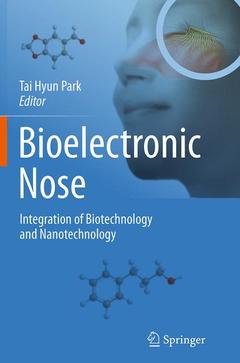Description
Bioelectronic Nose, Softcover reprint of the original 1st ed. 2014
Integration of Biotechnology and Nanotechnology
Coordinator: Park Tai Hyun
Language: English
Subjects for Bioelectronic Nose:
Keywords
Publication date: 09-2016
Support: Print on demand
Publication date: 05-2014
290 p. · 15.5x23.5 cm · Hardback
Description
/li>Contents
/li>Biography
/li>Comment
/li>
The ?bioelectronic nose?, the device which has a similar function to the human smell sensing system, can be realized by combining the olfactory cells or receptors with nanotechnology. In the last two decades, much has been learned about the smell sensing mechanism in biological systems. With knowledge about the biological olfactory system and the techniques for the expression of biological receptor proteins, we are able to utilize biological materials and systems to mimic the biological olfactory system. In addition to the advances in biological and biotechnological area, nanotechnology has progressed to a great degree. The bioelectronic nose is a good example of the integration of biotechnology and nanotechnology. This book describes basic biological sciences of the olfactory system, biotechnology for the production of olfactory biological elements, and nanotechnology for the development of various sensing devices. The purpose of this book is to provide the reader with a concept, basic sciences, fundamental technologies, applications, and perspectives of the bioelectronic nose.
Chapter 1. Concept of Bioelectronic Nose.-Chapter 2. Mechanisms of olfaction.-Chapter 3. Olfactory Receptor Proteins.-Chapter 4. Odorant-Receptor Interaction.-Chapter 5. Cell-Based System for Identification of Olfactory Receptors.-Chapter 6. Neurobiology and cultivation of olfactory receptor neurons on a chip.-Chapter 7. Production of Olfactory Receptors Using Commercial E.coli Cell-free Systems.-Chapter 8. Production of Olfactory Receptors and Nanosomes Using Yeast System for Bioelectronic noses .-Chapter 9. Production of Olfactory Receptor and Nanovesicle Using Heterologous Cell Systems for the Development of a Bioelectronic Nose.-Chapter 10. Biosensors Based on Odorant Binding Proteins.-Chapter 11. Optical Methods in Studies of Olfactory System.-Chapter 12. Carbon Nanotube-based Sensor Platform for Bioelectronic Nose.-Chapter 13. Conducting Polymer Nanomaterial-Based Sensor Platform for Bioelectronic Nose.-Chapter 14. Applications and Perspectives of the Bioelectronic Nose.
Provides overview from concept to development and future perspectives
Covers applications in wide variety of areas and industries and up to date overview of advances in olfactory sensing devices
Describes the various technologies for producing olfactory receptors and biosensors
Includes supplementary material: sn.pub/extras




